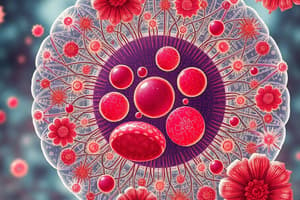Podcast
Questions and Answers
Which structure within the nucleus is primarily responsible for synthesizing ribosomes?
Which structure within the nucleus is primarily responsible for synthesizing ribosomes?
- Nucleoplasm
- Chromatin
- Nuclear membrane
- Nucleolus (correct)
What is the main function of the cell membrane in relation to its semi-permeable nature?
What is the main function of the cell membrane in relation to its semi-permeable nature?
- To control the transport of substances (correct)
- To facilitate cell division
- To store genetic information
- To provide structural support
Which of the following organelles is classified as non-membranous?
Which of the following organelles is classified as non-membranous?
- Endoplasmic reticulum
- Golgi apparatus
- Mitochondria
- Ribosomes (correct)
What role do nuclear pores play in the nuclear membrane?
What role do nuclear pores play in the nuclear membrane?
The chromatin in the nucleus is primarily composed of what materials?
The chromatin in the nucleus is primarily composed of what materials?
What is the primary function of the cell membrane?
What is the primary function of the cell membrane?
Which components make up the structure of the cell membrane?
Which components make up the structure of the cell membrane?
What technique is typically used to separate cell components based on their size and density?
What technique is typically used to separate cell components based on their size and density?
What do the terms 'intracellular' and 'extracellular' refer to in cell biology?
What do the terms 'intracellular' and 'extracellular' refer to in cell biology?
In the fluid mosaic model of the cell membrane, which component is NOT typically included?
In the fluid mosaic model of the cell membrane, which component is NOT typically included?
Flashcards are hidden until you start studying
Study Notes
Cell Structure and Function
- Cells are the basic units of life. They are responsible for all the functions of the body.
- Cells are complex and organized. They contain a variety of structures called organelles, each responsible for specific functions.
- The nucleus is the control center of the cell. It contains the DNA which directs all cellular activities.
- The cytoplasm is the jelly-like substance that fills the cell. It contains the organelles and other molecules necessary for life.
- The cell membrane is the outer boundary of the cell. It controls what enters and exits the cell and plays a role in communication between cells.
- The endoplasmic reticulum (ER) is a network of membranes that helps produce proteins and lipids. There are two types of ER: rough ER, which has ribosomes attached to it, and smooth ER, which does not.
- The Golgi apparatus modifies and packages proteins and lipids. It is a stack of flattened sacs that acts like a processing and distribution center.
- Lysosomes are the recycling centers of the cell. They contain enzymes that break down old or damaged cell parts.
- Mitochondria are the powerhouses of the cell. They generate energy for the cell through cellular respiration.
- Peroxisomes are small organelles that break down fatty acids and detoxify harmful compounds. They contain enzymes that use oxygen to break down these substances.
Endomembrane System
- Many cell organelles are connected through the endomembrane system.
- The endomembrane system includes the nuclear envelope, the endoplasmic reticulum, the Golgi apparatus, lysosomes, and vacuoles.
- Many of these organelles work together in synthesis, storage, and export of molecules.
Nucleus
- The nucleus is the largest organelle in animal cells.
- The nuclear membrane surrounds and protects the nucleus, containing pores for exchange between nucleoplasm and cytoplasm.
- The nucleoplasm is the liquid within the nucleus.
- The nucleolus is a sub organelle of the nucleus responsible for ribosome synthesis. It disappears during cell division.
- Chromatin is made up of DNA wrapped around proteins called histones. During cell division, chromatin condenses into chromosomes.
Lysosomes
- Lysosomes are membrane-bound organelles containing enzymes that break down large molecules.
- They are involved in:
- Digestion of large molecules.
- Recycling of cellular resources.
- Apoptosis (programmed cell death).
- Lysosomes help digest food particles engulfed by the cell through phagocytosis.
- They also remove and recycle damaged parts of a cell by autophagy.
Mitochondria
- Mitochondria are responsible for producing energy for the cell through cellular respiration.
- They have two membranes:
- Outer membrane (smooth).
- Inner membrane (folded), which contains components of the electron transport system and is impermeable to most ions.
- The matrix is the liquid within the inner membrane.
- Each mitochondrion has its own circular chromosomes and ribosomes, enabling it to self-replicate.
- Mitochondria play a key role in aging and apoptosis.
Peroxisomes
- Peroxisomes are small organelles that break down fatty acids and detoxify harmful compounds.
- They contain enzymes that use oxygen to break down these substances, producing hydrogen peroxide (H2O2) as a byproduct.
- Peroxisomes also contain catalase, an enzyme that converts toxic H2O2 into water.
- Peroxisomes are important for:
- Breaking down fatty acids into smaller molecules for use in cellular respiration.
- Detoxifying alcohol and other harmful compounds.
Disorders Related to Organelles
- Lysosomal disorders: Lysosomal storage diseases occur due to defects in lysosomal enzymes, leading to accumulation of undigested substances within cells.
- Mitochondrial disorders: Mutations in mitochondrial DNA (mtDNA) can cause various disorders, often affecting muscle function due to energy production problems.
- Peroxisomal disorders: Defective peroxisomal proteins can lead to several metabolic disorders, as they are involved in many vital pathways.
- Ribosomal disorders: Disorders can affect the synthesis of ribosomes, leading to problems with protein production. These disorders can have varying effects on different parts of the body.
Studying That Suits You
Use AI to generate personalized quizzes and flashcards to suit your learning preferences.




